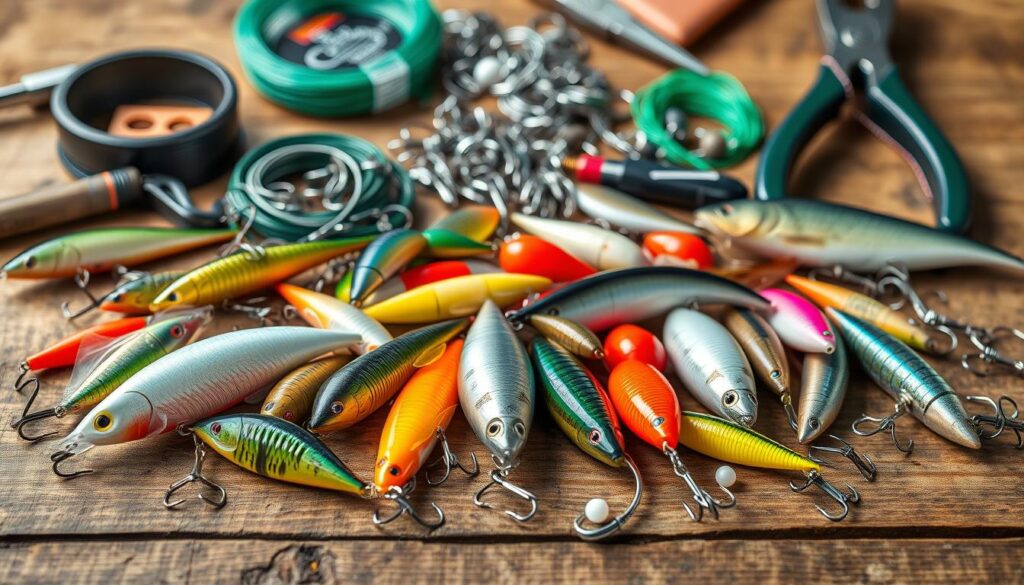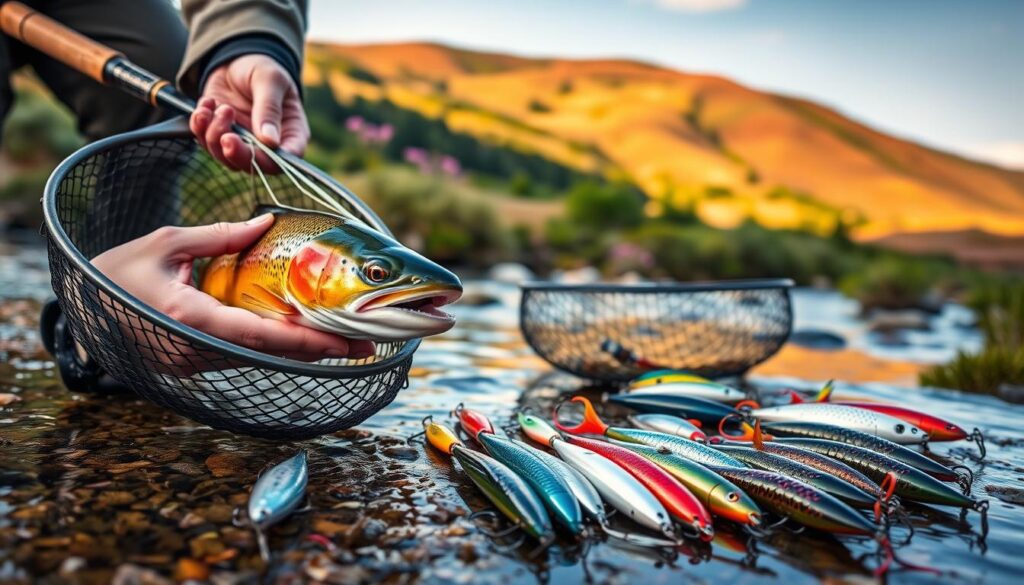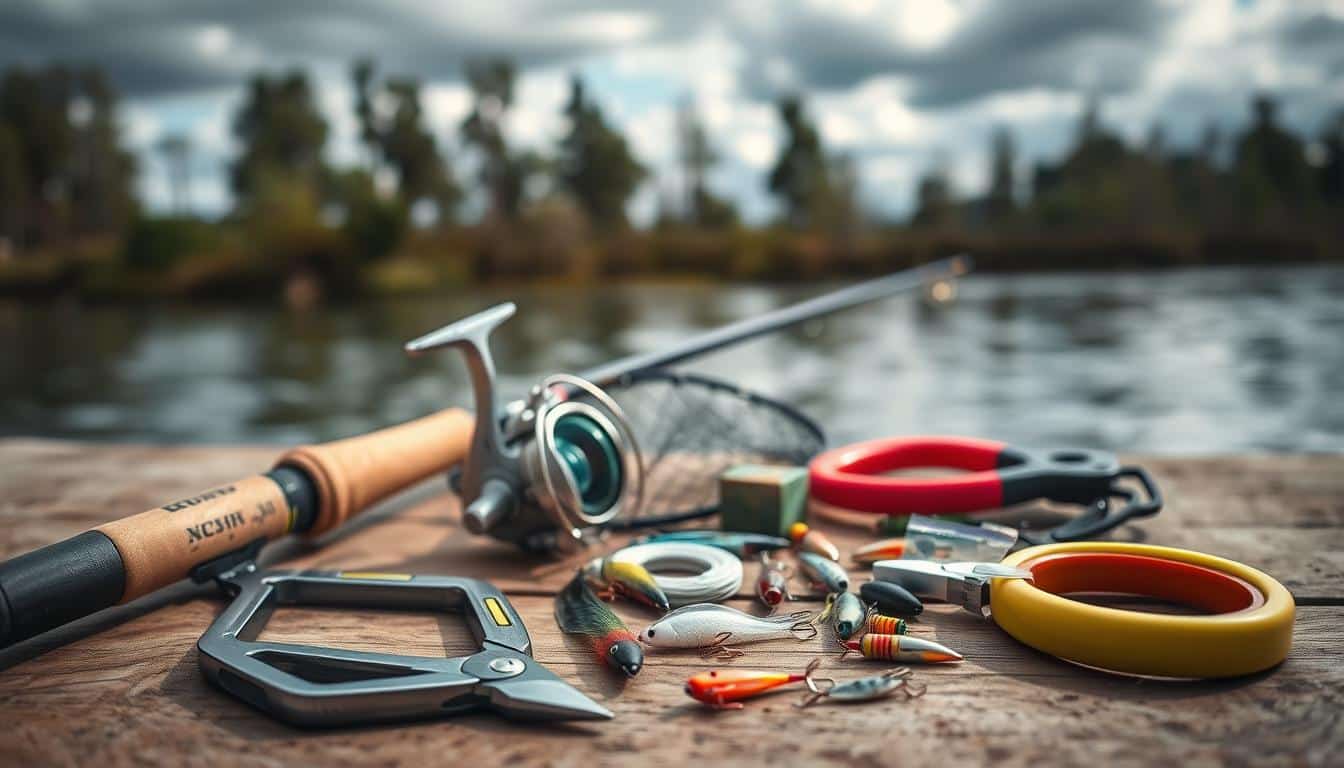Artificial lures are better for catch-and-release than worms or dead baitfish. They lead to less deep hooking. This makes it quicker and safer to remove the hook, helping bass, trout, and walleye survive after release.
When you use lures for catch and release, it shortens the fight time. You should match your rod, reel, and line to the fish you’re targeting. Less fighting time means the fish get less tired, improving their chance of survival. This is important for keeping fish populations healthy.
Modern lures use special vibration, colors, and scents to attract fish. Brands like Pure Fishing’s Gulp and Yo-Zuri are good examples. Using these lures with careful handling and fast release boosts the fish’s survival rate. This ensures better catch-and-release outcomes every time you fish.
How Artificial Lures Improve Catch & Release Success
Artificial lures reduce the chance of fish getting hurt and help them get back to the water quicker. Fish stay healthier and anglers catch more with less harm. This is why many are choosing artificial lures for fishing in the U.S.
Overview of benefits for fish welfare and angler success
Artificial lures don’t get swallowed as much as natural bait. This means less harm inside the fish and easier hook removal. Keeping handling short and the fish level helps their well-being.
Anglers can catch fish faster and control the bait better. This means more catches without needing live bait. It also saves time and keeps more baitfish alive.
Why this topic matters for sustainable recreational fishing in the United States
For fishing to last, we need to keep fish alive after catching them. Using lures that don’t hurt fish too much is key. This way, fish populations stay healthy, ensuring fishing for the future.
Warm weather makes some fish more likely to get hurt. By choosing artificial lures and limiting catch-and-release during hot times, we protect these fish. This matches fishing with taking care of nature.
How the article uses science and best practices to support recommendations
This advice is based on what we know about fish senses and lure design. Brands like Gulp and Yo-Zuri use science to make lures that fish will bite but are also safe to release.
The article shares tips backed by research and experts. It suggests using the right gear and handling fish carefully to make sure they survive after being let go.
Reduced Deep Hooking and Injury with Artificial Lures
Using artificial lures changes how fish attack. Anglers notice less gut or gill hookings with lures than live bait. Lures usually lead to strikes at the jaw, making hooks easier to remove safely.
Comparing swallow-depth: natural baits versus artificial lures
Natural baits are often swallowed whole. This can result in fish getting gut-hooked, which increases their chances of dying. Lures, however, are usually nibbled at, making the hook set in the mouth.
Circle hooks with natural bait reduce deep hookings by targeting the mouth. Using artificial lures with the right technique and hook size can give similar or improved results. This approach also lessens the need to handle swallowed bait.
Evidence and expert guidance on hooking location and survival
Studies show where a fish is hooked affects its survival. Hooks set in the jaw or lip lead to better survival rates than gill or gut hookings. Using tools like long-nose pliers helps remove hooks quickly when they’re easy to reach.
- Jaw hooks: higher survival, easier unhooking.
- Gill or gut hooks: greater injury, higher post-release mortality.
- Circles hooks: reduce deep hooking when used properly.
When to cut the line versus attempting hook removal to minimize harm
Experts recommend cutting the line when a hook is deep in the gill or gut. Trying to remove it can cause more harm and increase the chances of the fish dying. Hooks left in might not stop a fish from eating and can eventually corrode away.
To lessen handling time, keep pliers handy, hold the fish horizontally, avoid the gills, and release it quickly. Knowing when to cut the line or remove the hook can save fish lives and keep fishing fun for everyone.
Faster Fight Times and Less Exhaustion for Fish
Choosing the correct gear makes fishing fights shorter and saves fish. Pick the right rod, reel, and line for the fish you’re after. This method cuts down fight time and reduces the risk of the fish getting too tired, especially in hot water.
Using artificial lures usually hooks fish in the mouth. This lets fishermen pull in the fish steadily and quickly. Artificial lures help bring fish in faster without losing any fish or reducing the number you catch.
Gear match species
- Pick a medium-fast rod for bass, a lighter one for panfish, and stronger gear for catfish and tuna.
- Adjust the drag so the fish gets exhausted quickly but your line stays intact; always check your drag first.
- Opt for a line that’s tough but flexible; adding fluorocarbon leaders aids in secure hooking of big fish.
How lures shorten fights and reduce stress
Hydrodynamic lures and the right jigs let you control where and how you hook fish. They prevent fish from making deep dives, allowing you to pull fish away from obstacles easily. Shorter fights from these techniques mean fish recover quicker and are more likely to survive after being released.
Practical tips to land fish quicker
- Hook fish firmly when they bite and keep a constant tension to avoid giving them slack.
- If it’s allowed, use nets or rubber mats for fast handling; practice getting hooks out with one hand to speed up releasing fish.
- Bring in lures that are heavy or balanced quickly to stop fish from fighting too long underwater; change how fast you reel in based on the fish’s habits.
Anglers who use artificial lures often catch more fish each hour and win fights quicker. Getting better with lure tricks means less fight time but the same amount of catches. Small tweaks in your equipment and way of fishing lead to better outcomes for both the fish and the fisherman.
Lure Design, Fish Senses, and Targeted Attractants
Today’s lures appeal to fish by activating their senses. They use vibration, sound, and visuals to grab attention. Close-up, it’s the texture and smell that really draw them in. This smart design lessens the chance of fish swallowing lures deeply, favoring bites instead.
How vibration, sound, and visual cues in lures appeal to fish senses
Predatory fish sense sound and movement first, even before seeing the lure. The right kind of wobble and rhythm in a lure signals fish from afar. This clever trick convinces fish to strike, helping anglers catch them more efficiently.
Scented and textured soft plastics: when flavor and texture matter
Lures with textures and a soft feel improve the chance of fish holding on. Adding scent helps especially in dark or murky waters. With these lures, fishermen can attract even the most cautious fish, avoiding the need for live bait.
Hydrodynamic shape and action that mimic injured prey to trigger strikes
Lures shaped to move like hurt fish pause, flutter, and roll realistically. This imitation of injured fish tempts predators to bite quickly, avoiding deep swallowing. Choosing a design that looks like local fish can lead to more effective catches.
- Engineered vibration and tuned sound units reach fish before sight does.
- Scented soft plastics support attraction at close range and in low visibility.
- Hydrodynamic lure design creates believable injured prey mimicry and predictable action.
Improved Unhooking Practices Enabled by Artificial Lures
Artificial lures lead to more fish getting hooked in the mouth. This is easier and safer to remove, for both the fish and the angler. Always have your tools ready for a fast and calm release.
Less deep swallowing leads to easier and safer hook removal
Artificial lures usually hook fish in the jaw. It’s much safer to remove a hook from the mouth than from deeper inside. If the hook is too deep, just cut the line by the hook and let the fish go. This way, the fish suffers less harm.
Recommended tools: long-nose pliers, forceps, knotless rubber nets
- Keep long-nose pliers and forceps ready to gently remove hooks.
- A small, knotless rubber net protects the fish’s scales and slime coat.
- Have fine-point forceps for delicate hook work and a line cutter for quick cuts.
Handling protocols to protect mucus layer, gills, and eyes during unhooking
Wet your hands before handling a fish to save its protective mucus. Hold the fish gently, without touching its gills and eyes. Keep it out of the water for less than 15 seconds when taking pictures.
Get comfortable with your unhooking gear beforehand. Efficient use of tools and techniques lessens handling time. This helps the fish survive after it’s released. Using knotless nets and careful handling preserves the fish’s mucus and health.
Practical Advantages for Anglers That Support Conservation
Switching to artificial lures offers big benefits for those who fish and care about nature. Many fishermen find they only have a little bit of time to spend on the water. They find that fishing with artificial lures allows them to fish more and spend less time managing live bait.

With quicker prep, fishermen can avoid making rushed decisions. Faster trips mean less chance of keeping too many fish. These actions support conservation and help during warm seasons when fish are more at risk.
Time efficiency: more presentations, less time spent catching bait
- Using artificial lures means you can cast more in your fishing time. This ups your chances of a catch without harming smaller fish.
- Companies like Berkley Gulp and MirrOlure make lures that fish bite as much as they do live bait.
- Less bait handling means quicker starts and less harm to fish that aren’t being targeted.
Situational freedom: fishing from shore, kayak, or travel without live wells
- Fishing without needing live wells means you can easily fish from kayaks, backpacks, or small boats.
- Traveling fishermen enjoy not having to carry extra equipment like aerators or tanks.
- Lighter gear allows for fast moves when conditions change or fish move.
Responsible bait use and how switching to artificials reduces baitfish mortality
- Choosing artificial lures over live bait helps save small fish for bigger ones to eat.
- By only taking what you will use, we support a balanced ecosystem and bigger fish in the future.
- These decisions align with fishing in a way that looks after our waters and fish populations.
Anglers gain a lot and so do our water ecosystems by using modern lures. By picking artificial lures and fishing smart, fishermen can have great outings and help keep fisheries healthy for years to come.
Science and Technology Behind Modern Lure Effectiveness
Today’s lures use science and engineering for better fishing. They help catch fish faster and release them safely. Experts study fish habits and body functions to improve fishing tools. This makes gear better and helps anglers handle fish less.
Research on fish sensory biology and how lures are engineered to exploit it
Fish scientists have found that fish use sight, touch, and smell to find food. Using these senses helps make fake bait work better than real bait for some fish. Lures are made to look, move, and smell like real prey, which makes fish want to eat them.
Examples of innovations: tuned vibrations, color science, and scent delivery
- Vibration devices and ribbed shapes make waves in the water. These waves feel like real fish to other fish, making them bite.
- Special paints and shiny materials help lures look real in different water conditions. They can also hold scents to attract fish.
- Scented lures bring fish in by smelling like real food. They make fish bite hard but don’t let them swallow the hook too deep.
Case studies and expert commentary linking lure science to landing big fish with minimal harm
- Nomad’s baits use special vibrations to get fish to bite without hurting them. This means fish are caught by the mouth, not the throat.
- Savage Gear and Yo-Zuri improve chances of catching fish by shaping lures to move like real prey. This makes fights shorter and safer.
- Pure Fishing and Gulp show that the right scent gets fish closer without harming them. This also makes it quicker to let them go.
These stories show using the right design means catching more fish and keeping them alive. It’s about using what we know about fish senses. By picking the right equipment, anglers get big catches and do less harm. This makes fishing better for everyone.
Best Catch and Release Techniques When Using Artificial Lures
Using artificial lures helps anglers do a fast, gentle catch and release. It’s key to plan your steps before taking the fish out of the water. This way, you can take photos, measure, and unhook quickly with little harm to the fish.

Minimizing air exposure
Try to keep the fish out of water for less than 15 seconds when taking photos or measuring it. Have your camera, measuring board, and pliers ready. If you’re taking a photo, shoot multiple pictures quickly with someone’s help to hold the fish. This makes it quicker to let the fish go back safely.
Correct handling posture
Always hold the fish horizontally to avoid hurting its spine or organs. Don’t squeeze its belly, touch its gills, or rub its eyes. Before touching the fish, wet your hands to keep its protective slime layer safe. Use the right way of holding for every fish you catch.
Net selection and usage
Pick a small, smooth net made of rubber or soft cotton that fits the size of your fish. This kind of net is gentle and doesn’t hurt the fish. Once the fish is caught, keep it over the water and remove the hook while it’s still in the net if you can. Use tools like long-nose pliers for safe and quick hook removal.
When to release or retain
Let the fish go right away if it can swim off strongly. But if the fish is bleeding a lot, has bad gill damage, or can’t stay upright, check the local fishing rules to see if you should keep it. Sometimes, especially in hot water or when the oxygen is low, it might be kinder to keep the fish instead of releasing it to suffer.
- Prepare tools and camera before casting to reduce handling time.
- Prefer artificials for faster hookups and quicker landings to support catch and release best practices artificials.
- When a hook is deep, cut the line close to the hook rather than prolonging removal.
- Fish caught early in the day face cooler water and better recovery odds.
Conclusion
Using artificial lures can help reduce harm to fish, making it easier to release them safely. These lures make it less likely to deeply hook the fish. Pair this with gentle handling to protect them.
To do this well, avoid lifting fish out of water for too long. Always keep them horizontal. Be careful not to touch their gills or eyes. Use smooth, knotless nets and pliers to help with removal. If a hook gets stuck, just cut the line.
These steps also need the right gear to reduce the time a fish fights. Be mindful of fishing in hot weather, as it can stress the fish. By following these tips, your fishing will be more ethical and effective.
For fishermen, using artificial lures means you can fish more quickly and with better control. This helps reduce the death of small baitfish. Knowing when to use live bait and when to use lures can lead to more fish caught. This helps keep fish numbers steady.
Technology is also improving lures, based on research into what fish see and smell. Experts like Dr. Dave Ross and Greg Myerson are leading this charge. By picking lures with this in mind, and handling fish correctly, we can fish without hurting fish numbers. Anglers stay successful, and fish stay plentiful.
FAQ
How do artificial lures improve catch-and-release success?
What specific benefits do artificial lures offer anglers and fish welfare?
Why does this topic matter for sustainable recreational fishing in the United States?
How does the article ground its recommendations in science and best practices?
Are artificial lures really swallowed less deeply than natural baits?
What should I do if a hook is deeply embedded in the gill or gut?
How should I match rod, reel, and line to reduce fight time and exhaustion?
How do artificial lures help shorten fight times without reducing catch rates?
What lure features most influence hooking location and strike type?
When are scented soft plastics or flavor-bearing lures most useful?
What unhooking tools and nets are recommended?
What handling steps preserve the protective mucus layer and reduce infection risk?
When should I avoid catch-and-release because of temperature or species vulnerability?
How do artificials reduce baitfish mortality and ecosystem impacts?
Can advanced lure technologies really match or outperform live bait?
What practical steps speed release and improve survival when using artificials?
Are there cases when removing a deeply embedded hook is better than cutting the line?
How do I choose the right artificial for specific conditions and target species?
What ethical rules should anglers follow when using artificials?
Where can I learn more about lure science and best catch-and-release practices?
Content created with the help of Artificial Intelligence.



